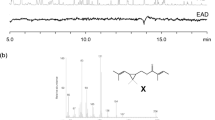Abstract
The stereoselectivity of the enzymatic hydration of disparlure, the pheromone for the gypsy mothLymantria dispar, and for twomeso analogues was determined. A single expoxide hydrase (EH), present in various male and female moth tissues, converted disparlure and the analogues to their respectivethreo-(R,R)-diols with high stereoselectivity as determined by analysis of the diols by chiral phase capillary gas chromatography. This EH recognizes thecis-nature of the dialkyl oxirane, but shows poor discrimination of the two alkyl chains.
Similar content being viewed by others
References
S.M.G. and G.D.P thank the United States Department of Agriculture for financial support and Dr Y. Masaki (Gifu University, Japan) for a generous gift of authenticthreo-(7S,8S)-2-methyloctadecanediol.
Baker, T. C., Experientia45 (1989) 248.
Bierl, B. A., Beroza, M., and Collier, C. W., Science170 (1970) 87.
Mori, K., and Ebata, T., Tetrahedron42 (1986) 3471, and references cited therein.
Hansen, K., Physiol. Ent. 9 (1984) 9, and references cited therein.
Cardé, R. T., in: Behavior Modifying Chemicals for Insect Pest Management, p. 51. Eds R. L. Ridgway, R. M. Silverstein and M. N. Inscoe. Dekker, New York 1990.
Kolodny-Hirsch, D. M., and Schwalbe, C. P., in: Behavior Modifying Chemicals for Insect Pest Managment, p. 363. Eds R. L. Ridgway, R. M. Silverstein and M. N. Inscoe. Dekker, New York 1990.
Prestwich, G. D., in: Pheromone Biochemistry, p. 474. Eds G. D. Prestwich and G. J. Blomquist, Academic Press, New York 1987.
Vogt, R. G., in: Pheromone Biochemistry, p. 385. Eds G. D. Prestwich and G. J. Blomquist. Academic Press, New York 1987.
Prestwich, G. D., Graham, S. M., Kuo, J.-W., and Vogt, R. G., J. Am. chem. Soc.111 (1989) 636.
Prestwich, G. D., Graham, S. M. and König, W. A., J. chem. Soc., chem. Commun. (1989) 575.
Graham, S. M., Ph.D. thesis. State University of New York at Stony Brook, 1990.
König, W. A., in: The Practice of Enantiomer Separation by Capillary Gas Chromatography, p. 12. Hüthig, Heidelberg 1987.
Vogt, R. G., Köhne, A. C., Dubnau, J. T., and Prestwich, G. D., J. Neurosci.9 (1989) 3332.
Wixtrom, R. N., and Hammock, B. D., in: Biochemical Pharmacology and Toxicology, vol. 1, p. 1. Eds D. Zakim and D. A. Vessey, Wiley, New York 1985.
Graham, S. M., and Prestwich, G. D., unpublished results.
Author information
Authors and Affiliations
Rights and permissions
About this article
Cite this article
Graham, S.M., Prestwich, G.D. Tissue distribution and substrate specificity of an epoxide hydrase in the gypsy moth, Lymantria dispar. Experientia 48, 19–21 (1992). https://doi.org/10.1007/BF01923597
Received:
Accepted:
Published:
Issue Date:
DOI: https://doi.org/10.1007/BF01923597




